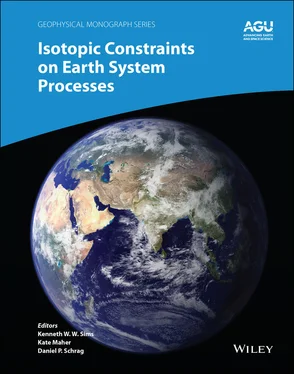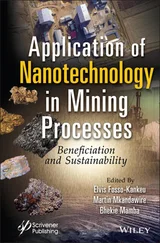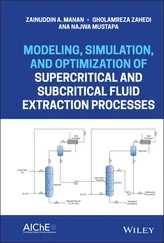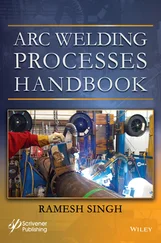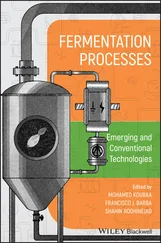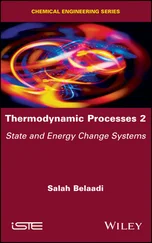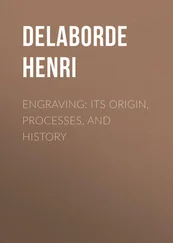Isotopic Constraints on Earth System Processes
Здесь есть возможность читать онлайн «Isotopic Constraints on Earth System Processes» — ознакомительный отрывок электронной книги совершенно бесплатно, а после прочтения отрывка купить полную версию. В некоторых случаях можно слушать аудио, скачать через торрент в формате fb2 и присутствует краткое содержание. Жанр: unrecognised, на английском языке. Описание произведения, (предисловие) а так же отзывы посетителей доступны на портале библиотеки ЛибКат.
- Название:Isotopic Constraints on Earth System Processes
- Автор:
- Жанр:
- Год:неизвестен
- ISBN:нет данных
- Рейтинг книги:4 / 5. Голосов: 1
-
Избранное:Добавить в избранное
- Отзывы:
-
Ваша оценка:
- 80
- 1
- 2
- 3
- 4
- 5
Isotopic Constraints on Earth System Processes: краткое содержание, описание и аннотация
Предлагаем к чтению аннотацию, описание, краткое содержание или предисловие (зависит от того, что написал сам автор книги «Isotopic Constraints on Earth System Processes»). Если вы не нашли необходимую информацию о книге — напишите в комментариях, мы постараемся отыскать её.
Volume highlights include: Isotopic Constraints on Earth System Processes
The American Geophysical Union promotes discovery in Earth and space science for the benefit of humanity. Its publications disseminate scientific knowledge and provide resources for researchers, students, and professionals.
Isotopic Constraints on Earth System Processes — читать онлайн ознакомительный отрывок
Ниже представлен текст книги, разбитый по страницам. Система сохранения места последней прочитанной страницы, позволяет с удобством читать онлайн бесплатно книгу «Isotopic Constraints on Earth System Processes», без необходимости каждый раз заново искать на чём Вы остановились. Поставьте закладку, и сможете в любой момент перейти на страницу, на которой закончили чтение.
Интервал:
Закладка:
There are several ways to explain the decoupling of the calcium isotopes and the more traditional geochemical carbonate sediment signatures. First, the calcium isotope compositions of the subducted carbonates could have had little mass‐fractionated calcium (i.e., Blattler & Higgins, 2017; Farkas et al., 2007) or their original light calcium isotopic signatures could have been modified, perhaps during diagenesis, prior to subduction and therefore have had limited effect on the calcium isotope composition of the studied arc magmas. I rule this out because it is unlikely that modern (≤35 Ma) subducted carbonate sediments had BSE‐like calcium isotope compositions, as shown by the work of Fantle and Tipper (2014; references therein). Likewise, even while the enhanced reaction in young carbonates increases the diagenetic effects, and therefore their δ 44Ca, the maximum effect (<0.15‰) of diagenesis is not large enough to erase the ≥0.3‰ light isotope effects typical of the carbonates; see Fantle and DePaolo (2007).
Second, it is possible that the flux of subducted sediment to the arc, and in particular marine carbonate, is overestimated. Despite the large volumes (100s m thick) of carbonate inferred from the DSDP drill cores from the subducting sediment sequence along the volcanic front, it is unknown how much sediment‐derived calcium is hybridized within the source reservoir(s) of the arc magmas. On average CaO is 4–5× more enriched in the carbonate sediment than the arc magmas. MORB‐like magmas have CaO contents that are the same or slightly higher than comparable primitive arc basalts (Patino et al. 1997; Presnall & Hoover, 1987). So, unlike Pb, Sr, and Nd that are found in relatively low abundances in the mantle, and therefore must come from a subducted component, perhaps sediments, to explain the elevated abundances in the arc basalts, all of the CaO needed in the arc basalts can be potentially provided by the mantle. For the most part these trace elements also behave incompatibly and will preferentially contribute, along with H 2O and other fluid mobile LILE, to the arc flux. In contrast, calcium acts compatibly. Therefore, any process that creates new Ca‐bearing phases, such as the “reaction pyroxenite” described by Straub et al. (2008; 2011), would effectively trap sediment‐derived Ca. As this material sinks into the mantle, this may help explain why some or most subducted carbonate calcium is added to long, deep mantle convection cycles contributing to the formation of ocean island basalts as suggested by Huang et al. (2011) (and possibly the carbonatites discussed in the following section), rather than the arc.
Third, the calcium isotope signatures may reflect a scenario in which the light calcium isotopic signatures of the subducted sediment are diluted by mixture with relatively heavy calcium reservoir(s), i.e., seawater and/or crustal rocks with BSE calcium isotopic compositions. Clear evidence of sediment subduction in the Central American arc is complicated by the fact that the radiogenic isotope compositions of the subducted sediments are relatively unradiogenic for marine sediments (cf. Feigenson et al., 2004). The exception may be Guatemalan lava AT‐50, but notably its Nd‐Sr isotopes could also reflect addition of crust and not necessarily subducted sediment ( Fig. 3.4). Some of the trace element variability used as evidence for subducted sediment (Ba/Th) could also be explained by the mobilization of Ba over Th in fluids derived from subducted altered oceanic crust ( Fig. 3.4) as seen in oceanic island arc basalts (Hawkesworth et al., 1997; Turner et al., 1996). Moreover, calcium mobilized in fluids extracted via deserpentinization reactions, as subducted rocks rise in temperature and pressure, might buffer the light carbonate signatures. It has been reported that subducted fluids could evolve isotopically during transport and fluid‐rock interaction, becoming enriched in heavy isotopes as they rise through the slab into the subvolcanic arc (John et al., 2012). It follows that mixing with isotopically heavy altered oceanic crust could offset the effects of the calcium from carbonate sediment, which is isotopically light, and produce BSE calcium isotope compositions for the arc lavas.
3.4.4. Mantle Source(s) of Calcium in Carbonatite Magmas
The similar δ 44Ca of the studied Oldoinyo Lengai carbonatite lavas and terrestrial basalts (i.e., BSE composition) suggests a mantle source for their calcium. This interpretation is consistent with the general consensus that carbonatites originate from low‐degrees of partial melting of the mantle (see Bell & Tiltonm, 2002; Walter et al., 2008). It is also consistent with studies that conclude carbonatite volcanoes extrude primordial volatiles (CO 2, He, N 2, and Ar) that are indistinguishable from those emitted along mid‐ocean ridges despite the fact that Oldoinyo Lengai carbonatites occur in a setting far removed from oceanic spreading centers (Fisher et al., 2009). It is possible that Oldoinyo Lengai lavas, which are natrocarbonatite, are not representative of more Ca‐rich carbonatite magmas. Extruded carbonatites, being composed largely of soluble carbonates, are easily weathered and therefore unlikely to be preserved in the geological record. The question of why this volcano extrudes lavas that are chemically different to older carbonatite centers, and whether ancient carbonatites were all originally natrocarbonatites and subsequently altered to calciocarbonatites, remains unanswered (Dawson et al., 1987; Zaitsev & Keller, 2006).
3.4.5. Origin of the Light Calcium Isotope Composition of Laacher See and other Intrusive Carbonatites
The distinctly light calcium isotope signature (δ 44Ca = –0.39 ± 0.14‰ [2σ]) of the intrusive Laacher See carbonatite is the sole outlier in this study, and is distinct from what is found in most igneous samples (see compilations in Antonelli & Simon, 2020; Schiller et al., 2016). It is possible that the mass‐dependent calcium isotopic deficit seen in Laacher See carbonatite is an artifact produced by relatively large (~4 epsilon‐unit) radiogenic 40Ca effects, as can be seen in Precambrian samples (e.g., Antonelli et al., 2019c; Mills et al., 2018; Simon et al., 2009). This is unlikely given the fact that the carbonatite clast studied was cogenetic with its ~12.9 ka phonolite host, which exhibits negligible evidence for assimilation, and contained zircons that range from 32.6 ± 4.1 ka to near‐eruption in age (Schmitt et al., 2010).
The calcium isotope composition of the Laacher See carbonatite could originate from recycling of isotopically light marine carbonate as suggested recently for other carbonatites (Amsellem et al., 2020). This would involve carbonate subduction through a long deep convection cycle, which is required given the fact that the East Eifel Volcanic Field is in Central Europe, far from a modern subduction zone. Amsellem et al. (2020) recently reported light calcium isotope data for a large number of Ca‐, Mg‐, and Fe‐rich carbonatites spanning from ~3 Ga to ~1 Ma. Their findings are important because they may provide timing constraints for the onset of plate tectonics and subduction of marine sediments. Furthermore, their conclusions imply that since at least 3 Ga there has been relatively similar levels of marine biomineralization, seawater conditions, and continental weathering to produce isotopically light marine carbonate. This does not appear to be true, however, as over approximately the same timespan (~3.0 to 0.7 Ga) there is little evidence for isotopically light marine carbonate in the geologic record (Blatter & Higgins, 2017). In fact, the extensive Precambrian carbonate record reported by Blatter and Higgins (2017) is dominated by BSE calcium isotope compositions. This record poses a serious problem for the interpretations of Amsellem et al. (2020), which necessitate that ancient carbonatites form from recycled light marine carbonates.
Читать дальшеИнтервал:
Закладка:
Похожие книги на «Isotopic Constraints on Earth System Processes»
Представляем Вашему вниманию похожие книги на «Isotopic Constraints on Earth System Processes» списком для выбора. Мы отобрали схожую по названию и смыслу литературу в надежде предоставить читателям больше вариантов отыскать новые, интересные, ещё непрочитанные произведения.
Обсуждение, отзывы о книге «Isotopic Constraints on Earth System Processes» и просто собственные мнения читателей. Оставьте ваши комментарии, напишите, что Вы думаете о произведении, его смысле или главных героях. Укажите что конкретно понравилось, а что нет, и почему Вы так считаете.
